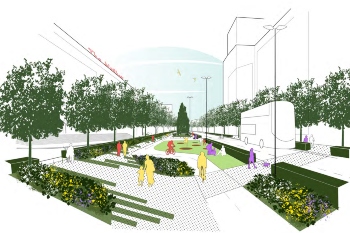
Cities across the UK are facing multiple challenges. The COVID-19 pandemic has led many people to avoid city centres and highstreets, which were already facing a decline in footfall. Britain’s exit from the EU has also come at a cost to urban areas, and all of this is against a background of climate change and air quality concerns. A lot needs to be done to ensure British cities remain resilient.
The architects and urban designers Broadway Malyan have created a toolkit aimed at supporting just such efforts. They were first approached by Birmingham’s Colmore and Retail Business Improvement Districts (BIDs) who commissioned them to create a masterplan that would help local decision makers transform Birmingham city centre into a greener, safer and healthier place to live.
The toolkit they have produced – the Going Green Masterplan – could also be useful for decision makers in other cities.
Broadway Malyan began by identifying Birmingham city centre’s existing green infrastructure (GI) such as planters, wildlife ponds, and parks. They found the districts to be heavily urbanised, with low quality biodiversity, pollution issues, flooding risks, and ‘heat island’ effects, where buildings absorb and emit lots of heat. All of these factors can have an impact on the health and wellbeing of residents.
Drawing on this information, they created a toolkit that can help Birmingham’s local decision makers make informed choices when implementing GI. It allows place makers to easily assess the costs and benefits of installing – for example – living lampposts and city scale parks. As the Going Green Masterplan’s introduction puts it: ‘The strategic proposals are presented in a user friendly format that allows for easy selection of intervention, clear understanding of benefits and associated delivery considerations (to assist with application for funding), and ultimately implementation of GI on the streets of Birmingham.’
Danny Crump, director of Urbanism at Broadway Malyan and one of only 20 UK landscape architects on the High Street Task Force Placemaking Experts panel, commented: ‘Often we see reports with fantastic recommendations, but which don’t consider the real-life challenges, such as securing funding or planning permission. We wanted the proposals in our masterplan to be as deliverable as possible.’
He continued: ‘Birmingham is one of many urban centres across the globe facing huge challenges. The slow COVID-19 recovery still depletes highstreets and city centre life. The impact of the climate crisis is more and more visible, as is the world-wide loss of biodiversity. As urban designers, of huge importance to us is how city centres affect not just people’s health and wellbeing, but their safety and quality of life. If we truly want to have an impact on these shared issues, we can no longer afford to provide blue-sky thinking. We must come up with a clear roadmap for change.
‘Creating a Green Infrastructure Masterplan for the City Core provides the unique opportunity to demonstrate the benefits of GI in addressing global challenges, and to reinstate the status of the city centre as a driver of commercial, creative, scientific, political and cultural life that influences way beyond its borders.’
The Going Green Masterplan received £50,000 funding from Greater Birmingham and Solihull Local Enterprise Partnership (GBSLEP) as part of the Towns and Local Centres programme. Clean growth is one of GBSLEP’s key strategic delivery themes and this toolkit – they say – will encourage the ‘greening’ of the existing built environment.
‘Creating greener and cleaner places for all of us is not a choice but a priority if we are to help our city-centres reach net zero targets and mitigate the impacts of climate breakdown,’ said Louise Brooke-Smith, GBSLEP Board Director for Place.
‘This work builds upon our partnership with Colmore and Retail BIDs to ensure we help catalyse investment into the city centre. Our ambition is to create places that are greener and a city that is sustainable.’
Crucially, the process and methodology created by Broadway Malyan are transferable to other cities. If the post-COVID green recovery is to be meaningful, local place makers are going to need the right tools. The Going Green Masterplan will be one such tool.












